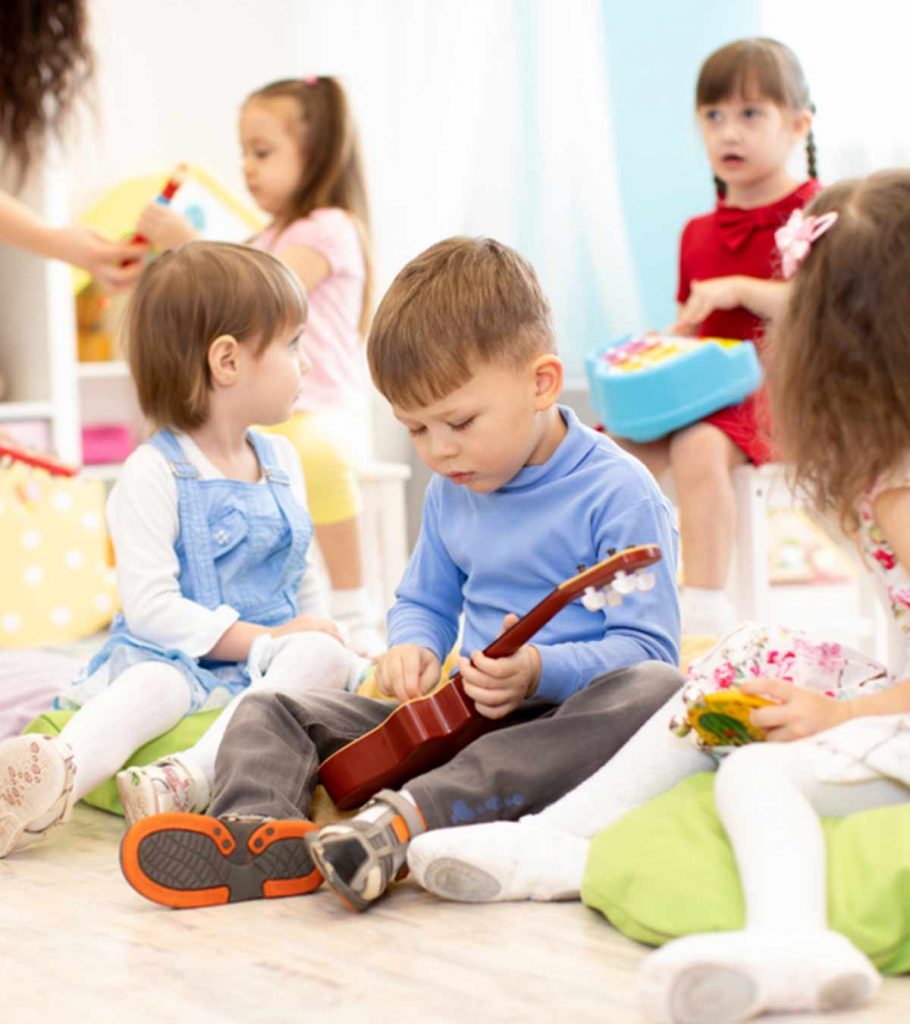Image: Shutterstock
It is a delightful sight to see toddlers beginning to interact with each other. This initial stage of social interaction helps your preschooler achieve important milestones.
At the age of three and four years, toddlers start participating in activities with other children of their age. Their focus will be on the other children or the object involved in the play and not on the activity as such. Also, in these group activities, you will notice that there isn’t much interaction between the toddlers and no organization to achieve a common goal. This type of play is called associative play (1) (2).
Read on as well tell you what associative play is and how it benefits your toddler. But first, to get a better understanding of associative play, let’s understand in brief the six stages of play.
Stages Of Play
Mildred Bernice Parten Newhall, a researcher at the University of Minnesota’s Institute of Child Development, developed the theory of six stages of play that children experience. Associative play falls into the fifth category. Let’s learn about each of these stages (2) (3).
- Unoccupied play (0–3 months old): The baby only observes and does not play in this stage. They may make some movements and learn how their body moves.
- Solitary play (0–2 years old): The baby starts playing alone and concentrating on activities, such as playing with building blocks.
- Onlooker play (2 years old): The baby begins to gain interest in others playing around but only watches them and does not interact with them.
- Parallel play (2–3 years old): The child starts playing near others, but not with them. They may play alone and, sometimes, imitate the actions of other children around them.
- Associative play (3–4 years old): The child begins to develop an interest in people around them. The child may do the same activity as other children, but there will be very little interaction and no organization.
- Cooperative play (4+ years old): The child is involved in communication and takes an active part in the activity at hand. There is cooperative play, organization, and teamwork.
Examples Of Associative Play
The following are some examples of activities that children usually indulge in during associative play.
- Building a tower of blocks without planning and competition
- Sharing the same playground and using the same play equipment, such as slides, swings, merry-go-rounds, and climbers
- Cycling next to other children without choosing a destination
- Playing dress-up for a Halloween party or pirate-themed party
- Sharing a play kitchen and using play utensils, toys, etc.
- Painting or doing other craft art using the same material, but not commenting on each other’s work or completing the art together
- Playing with the same toy without chatting with each other
- Doing activities such as puzzles or connect-the-dots in preschool
- Dancing at a party without any competition with each other
- Eating their meals together during recess
- Forming a line to go to the washroom
- Running around in a circle without a motive to catch each other
Benefits Of Associative Play
Your child is no longer in their own world in the associative play stage. Their world is expanding as they start including people other than their caregivers into their lives. Associative play can help children develop valuable skills and learn important values. Here are some benefits of associative play (4) (5) (6) (7) (8) (9) (10).
- Cooperation and sharing: Although your child may not be involved in putting in joint efforts needed to achieve a common goal at this stage, associative play encourages them to share common resources, such as a swing or slide, and prepares them to take part in group activities.
- Respect and turn-taking: It can help them understand the importance of turn-taking and make them aware that there are certain rules for every activity and that these activities benefit the whole group. Also, as they play in a group setting, it could help them learn to respect each other.
- Problem-solving: The child starts exercising the skills they have learned during the onlooker play and parallel play stages. As they become more active during the associative play stage, they learn to find solutions to their problems by doing things themselves, observing other children, or interacting with other children to a certain extent.
- Language development: It is the stage where children start to interact with others in a social setting. Children would try to verbalize their feelings, which can help develop their vocabulary and enable them to form simple sentences.
- Preparedness for school: The communication and friendship skills acquired at this stage can help your child get comfortable in school. Mingling with children of the same age group and learning how to share, take turns, and cooperate can help them transition into school without much difficulty.
- Fitness: Participating in common activities with other children can make them more active. Staying active and taking part in physical activities can help develop their motor skills and strengthen their bones and muscles.
- Brain development: Associative play helps boost their thinking capacity, concentration, imagination, cognition, and creativity. It is through play that children explore and make sense of the world around them. Taking part in activities can help stimulate their brain and engage their senses.
Now that you know associative play and its benefits for toddlers, take your child to places where they can interact with other children and make new friends. You could take them to preschools, daycares, or even gardens. It is a crucial stage in which your child learns to adjust to the changes around them, which can help them transition from staying at home with caregivers to being at school with peers and teachers effortlessly.
Allow your child to explore the world around them. Don’t be possessive if you don’t find yourself grabbing all the attention of your toddler during this transition stage, as you will always be their favorite person.
